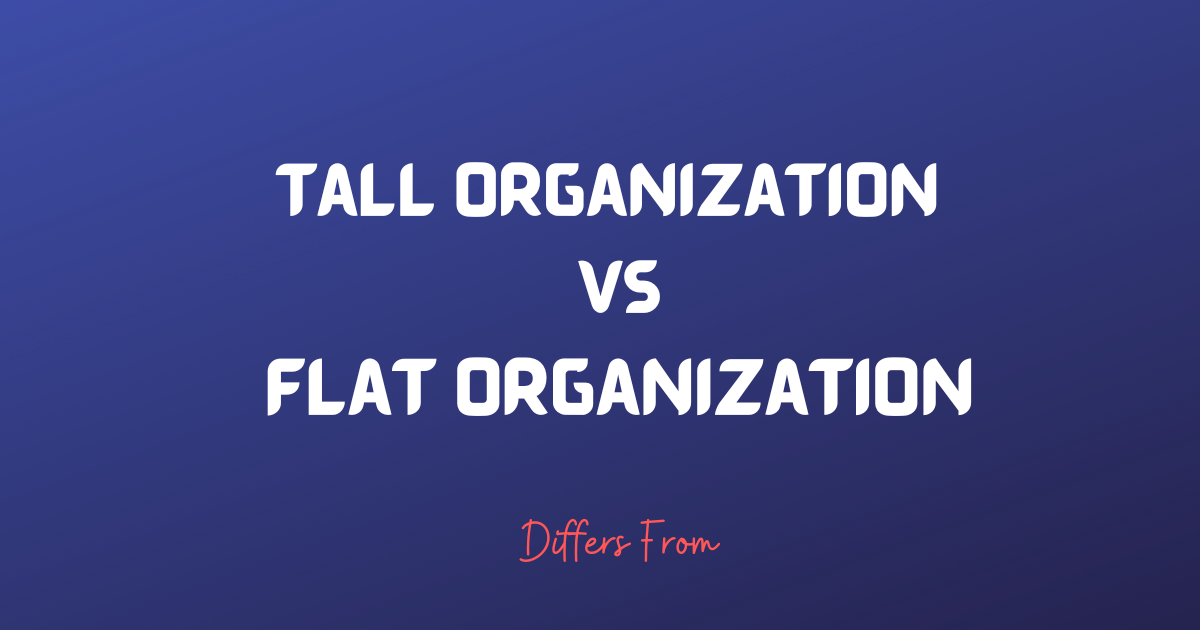Organizational Structure:
Organizational structure is the framework of the relationships between occupations, systems, operating processes, individuals, and groups working to achieve objectives. It refers to how work moves through an organization. It enables group members to collaborate within their different roles to manage tasks. Insurance firms, engineering firms, legal firms, regulatory organizations, etc.
Different Types of Organizational Structures:
An organizational structure outlines how certain activities are directed to achieve the goals of an organization. The four organizational structures are functional, divisional, futarchy, and matrix.
Hierarchical structure
The employees in a hierarchical organizational system are grouped and assigned a supervisor. It is the most popular organizational structure type. Employees may be grouped based on their position or function, location, or the products or services they deliver. This system has numerous tiers of authority, with the greatest level of leadership at the top, their direct employees below them, and so on.
Functional structure
The organization is organized into groups based on their respective functions, responsibilities, or specializations in a functional structure. For instance, a company may have marketing, finance, and sales divisions, each supervised by a manager who simultaneously supervises other departments. A functional organization might be advantageous because departments can have confidence that their personnel has the skills and knowledge necessary to support their objectives.
Matrix structure
Employees with similar talents are placed together and report to more than one management in the matrix organizational structure, which resembles a grid. This frequently comprises a functional manager who monitors projects and their progress and a product manager who is in charge of the company’s product strategy and success. Large, international corporations commonly utilize the matrix structure to achieve goals by encouraging sharing of talents and knowledge across divisions.
Flat structure
Most middle management levels are eliminated with a flat organizational structure, leaving little between staff-level personnel and higher management. As a result, employees are given more responsibility and decision-making authority without the usual hierarchical pressures or oversight and are often more productive. Small businesses and early-stage start-ups typically choose this structure because they have fewer staff and projects to manage. A “horizontal structure” is another term for it.
Divisional Structure
In a divisional structure, organizations are divided into divisions based on distinct goods, services, or geography. As a result, major corporations that operate across large geographic areas or own distinct, smaller businesses generally employ this structure. Executive leadership, departments, and resources are all unique to each division. For example, a large software corporation might divide its structure into divisions based on product types, such as cloud software, corporate software, and personal computer software.
Line Structure
In a line structure, authority flows from top to bottom within the organization, and there are no specialized or supportive services. It is one of the most basic organizational structures available. A general manager oversees and controls the organization, which is organized into departments, each having its manager with power over its workforce. The departments collaborate to achieve the organization’s main aim.
Let us know about the Difference Between Tall and Flat Organization Structure
The organizational structure affects the performance of an organization:
Employees at all company levels benefit from organizational structure because it provides clarity. In addition, departments can work more like well-oiled machines if they pay attention to the organizational structure.
It was particularly concerned with the impact of hierarchy on employee performance, identifying characteristics that drive employees and assessing the impact of job satisfaction on employee performance. The findings also reveal that establishing a good organizational structure is critical for employees to perform successfully at work.
Organizational structures assist firms in ensuring that all duties required for profitable operations are assigned to the appropriate individuals. They also help personnel, from employees to executives, understand their jobs, whom they report to, and whom they supervise.
Tall Organization:
It is an organizational structure in which the leadership standard is vertical, with the CEO or owner as of the most powerful member who sets the aim. Tall organizations, in general, are exceedingly complex. This means that when the market changes, these businesses may react more slowly than usual because managers have a considerably narrower control range. Management is divided into multiple tiers in a tall organizational structure, with executives at the top and regular staff at the bottom.
Advantages
- More prospects for advancement, which may lead to higher employee motivation.
- Line managers provide additional support to employees.
- There is a higher level of oversight because each line manager is responsible for a small number of individuals.
Disadvantages
- There are numerous levels of hierarchy.
- The span of control is limited, and the chain of command is long, slowing communication as instructions pass through the organization’s levels.
- Longer communication lines can make a company less sensitive to change.
- Due to high wage costs, it can be costly to operate.
Flat Organization:
Between staff and executives, a flat organization has a structure with few or no intermediate management levels. As a result, employees are supervised less in a flat organization, encouraging them to participate more in decision-making. Valve, the gaming business behind masterpieces like Half-Life, Counter-Strike, Portal, and many others, is the most well-known example.
Advantages
Cost-effective:
A flat organizational structure has very few managerial layers. The corporation will have to spend less on managerial wages, benefits, and other expenses. The firm can save money and use it for other objectives when salary-related expenses decrease.
Increased employee retention:
In a vertical hierarchy, a highly skilled workforce’s innovation is limited, whereas, it is encouraged in a flat organizational structure. Employees feel a sense of accomplishment when they are allowed to demonstrate their creative abilities.
Increases employee morale:
Because there is no mid-level management, the front-line worker has a natural sense of responsibility.
Encourages quicker decisions:
A flat organizational structure has the advantage of reducing the number of persons with whom you must consult before making key decisions.
High productivity:
A flat organizational structure fosters a strong sense of ownership and responsibility, which leads to increased efficiency and productivity.
Encourages collaboration:
Collaboration is promoted in a flat organizational structure because all employees are on the same team.
Disadvantages
Limits growth:
Change is difficult with a flat organizational structure since new opportunities may not be appropriate for this structure. This could stifle an organization’s growth and general chaos.
Creates a power struggle:
Employees with a flat organizational structure are empowered to make their own decisions. However, because they do not have a direct boss to report to, confusion and a power struggle are owing to a lack of clarity.
Low motivation:
The climb gets difficult because there is very little room at the peak. Employees are less motivated as a result of this.
Function ambiguity:
In a flat organizational structure, people are expected to handle multiple responsibilities simultaneously, which confuses their essential role and accountability in the company.
There is a high risk of errors:
In a flat organizational structure, the first-line staff is heavily reliant. Therefore, if they lack the essential experience, they may make mistakes and have troubles, resulting in a loss for the organization.
Wasted time:
In a flat organizational structure, much time is wasted ensuring that others do not duplicate someone’s ideas.
Difference Between Tall and Flat Organization Structure
| Tall organization | Flat organization |
| 1. Tall organizational structures have more employees, and responsibilities. | 1. Flat organizational structures have smaller hierarchical setups. |
| 2. There may be less communication with customers. | 2. They may have more customer communication than tall organizations. |
| 3. A narrow span of control is seen in a tall structure. | 3. In a flat structure, the span of control is wide. |
| 4. More time is taken to make decisions in a tall structure since there are many levels of personnel to consider. | 4. Speed of decision making high in flat structures due to the wide span of control. |
| 5. Cost of managing a tall structure is costly since there are more layers of staff | 5. Costs related to a flat structure is relatively low compared to a tall structure. |
| 6. Opportunity for promotion is high in a tall structure. | 6. Limited opportunities are available for promotion in a flat structure. |
Tall organization vs. Flat organization
A tall company has a CEO at the top of the chain of command, with several levels of management below. In a flat organization, there are fewer tiers of administration, and employees have more autonomy in decision-making. The number of layers in the organizational hierarchy and the breadth of control are the major factors that determine whether a structure is tall or flat. Both structures have their own set of advantages and disadvantages. Thus keeping a structure with an average number of levels can help organizations reap the benefits of both. As previously said, the structure to be adopted is highly dependent on the nature of the product offering, industry, and clients. Small business owners often adopt a flat business structure when it comes to organizing their businesses. The hierarchical arrangements of flat organizational structures are smaller than those of tall ones. Because flat organizations have only a few managers to help arrange company matters, they have less oversight power and a shorter chain of command. At most, they can have three degrees of power. Customer communication may be better in flat organizational structures than in tower companies. Because of the reduced hierarchical arrangement, flat firms have more employees who communicate with customers.
Which is better: Tall or Flat organization?
Flatter structures are more adaptable to changes and more versatile. Faster communication leads to faster choices, but managers may face a higher workload. A flat structure raises employees’ responsibilities within the organization and eliminates unnecessary management layers. Employee decision-making is improved when there are fewer tiers between them. The organization’s budget is boosted by the lack of requirements for middle management. A flat organizational structure offers its own set of advantages. Because the layers of middle management are removed, power and responsibility are distributed fairly throughout the business. Having fewer levels of management also streamlines internal communication and allows for quick decision-making. Faster communication leads to faster choices, but managers may face a higher workload. Flat organizations, as opposed to military-type vertical structures, incline toward a more democratic form.
If you gather more different knowledge click here

